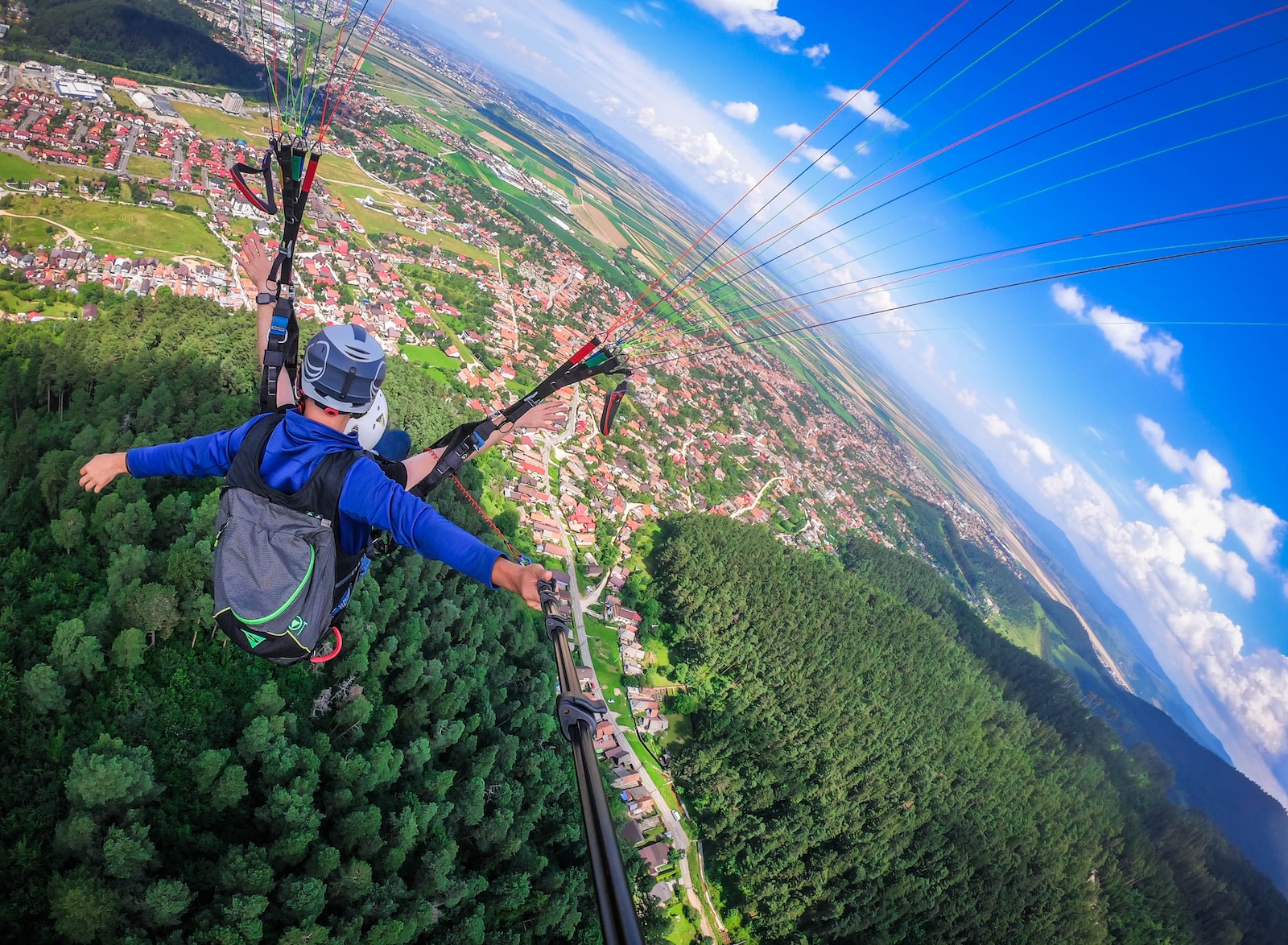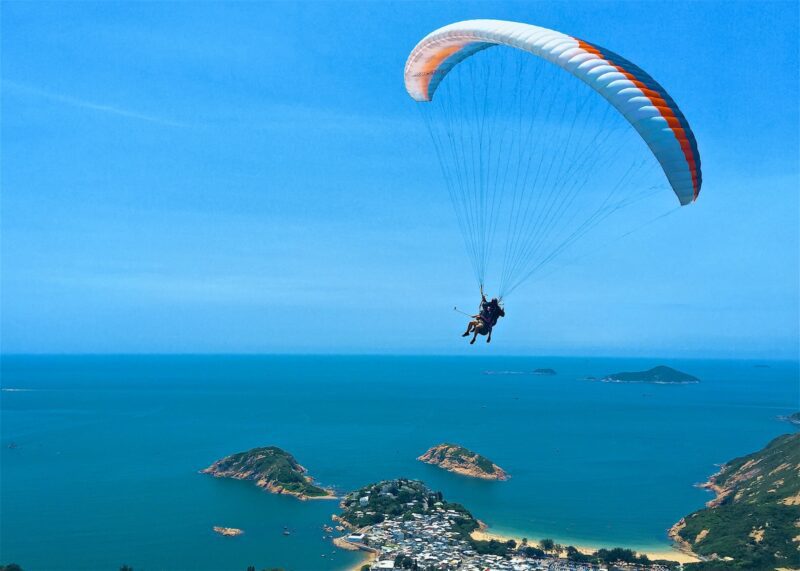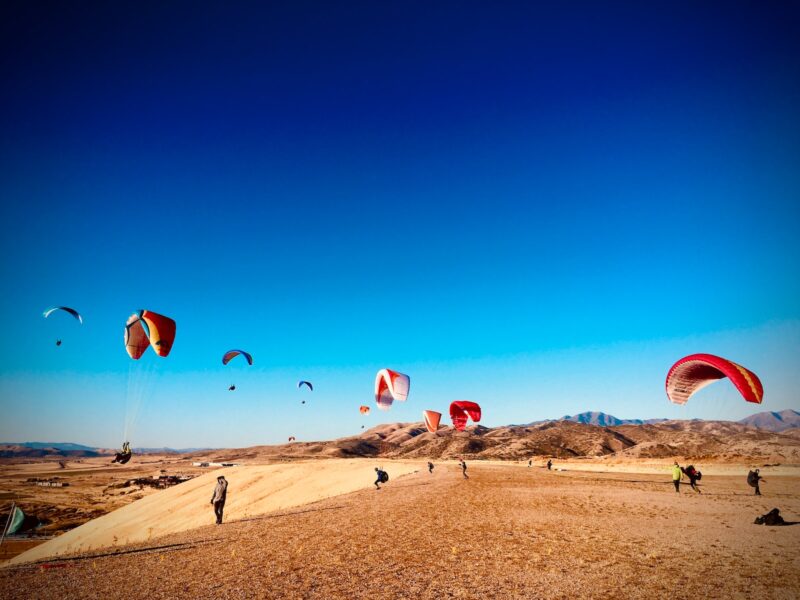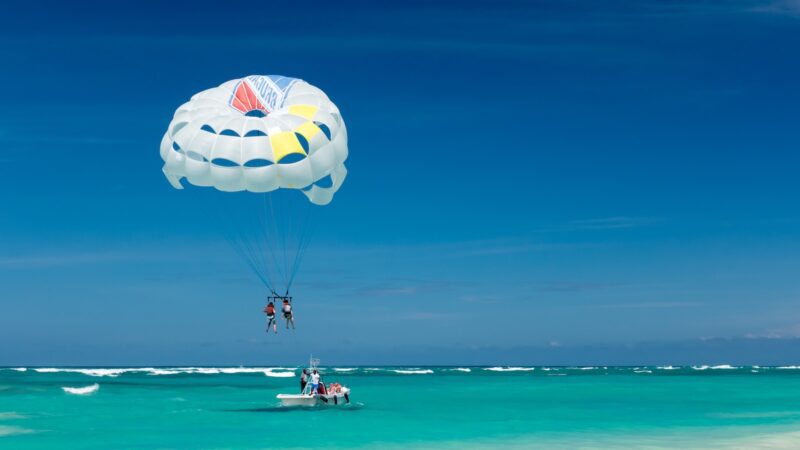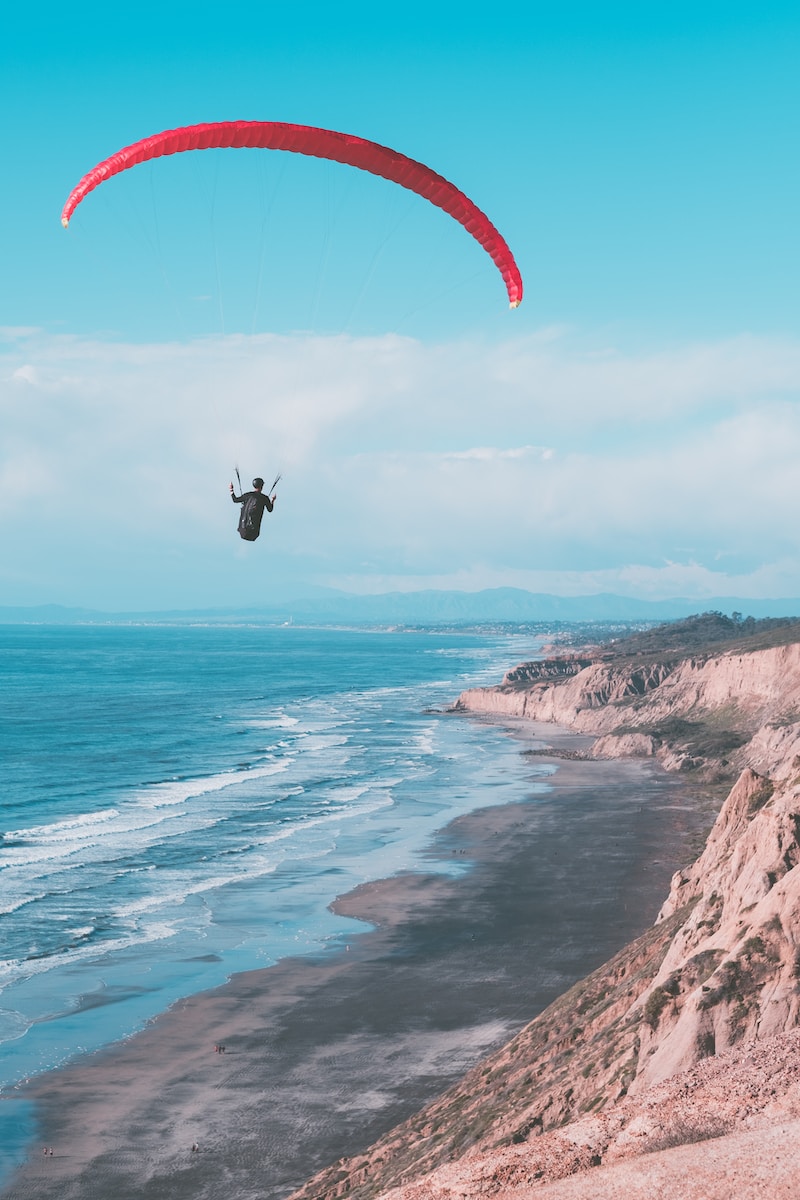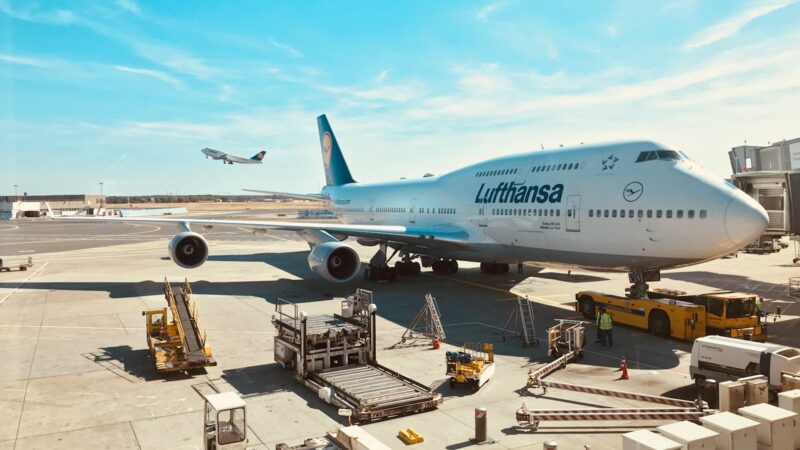Table of Contents
ToggleHang Gliding Vs Paragliding
Do you know the difference between hang gliding vs paragliding? Hang gliding and paragliding are two popular adventure sports that involve flying high in the sky, but they differ in several ways. Hang gliding is an air sport in which a pilot flies a non-motorized, foot-launched glider. The pilot hangs from a harness beneath a flexible wing, and controls the glider through weight-shift. On the other hand, paragliding is a recreational and competitive sport in which a pilot flies a lightweight, free-flying, foot-launched glider aircraft with no rigid primary structure. The pilot sits in a harness suspended below a fabric wing, and controls the glider through the use of brake lines.
Hang gliding is often considered more challenging and physically demanding than paragliding, as it requires more strength and skill to launch and control the glider. Hang gliders are also faster and more aerodynamic than paragliders, allowing pilots to fly longer distances and reach higher altitudes. However, paragliding is generally considered safer and more accessible, as it requires less equipment and training than hang gliding. Paragliders are also more maneuverable and can fly in lighter winds than hang gliders. Ultimately, the choice between hang gliding and paragliding comes down to personal preference and skill level. Read on for a more in-depth review of the two extreme sports.
You might also like this post on ziplining and this one on bungee jumping
Hang Gliding vs Paragliding: An Overview
Hang gliding and paragliding are two popular aerial sports that allow individuals to experience the thrill of flight. Both sports involve the use of a wing, but the design and operation of the wing differ between the two.
Hang gliding involves the use of a rigid wing, known as a hang glider, which is typically made of aluminum alloy or composite materials. The pilot is suspended from the wing in a harness, and controls the direction and speed of flight using weight shift and a control bar. Hang gliders are typically launched from hills or mountains, and can reach altitudes of up to 10,000 feet.
Paragliding, on the other hand, uses a flexible wing, known as a paraglider, which is made of ripstop nylon fabric. The pilot is seated in a harness, and controls the direction and speed of flight using brake lines attached to the trailing edge of the wing. Paragliders are typically launched from flat ground, and can reach altitudes of up to 18,000 feet.
Both hang gliding and paragliding offer unique experiences and challenges. Hang gliding provides a more stable and efficient form of flight, while paragliding offers a more versatile and maneuverable wing. The choice between the two ultimately comes down to personal preference and the type of flying experience one is looking for.
Hang Gliding vs Paragliding: Equipment and Gear
When it comes to hang gliding and paragliding, the equipment and gear used for each activity is quite different. Both require specialized equipment to ensure safety and optimal performance.
Hang Gliding Equipment
Hang gliding equipment typically consists of a rigid structure made of aluminum or composite materials that is covered with a sail or wing made of fabric. The pilot is suspended from the structure by a harness, which is connected to the wing by a series of lines. The pilot uses a control bar to steer the glider and adjust the pitch of the wing.
The shape of the wing is critical for optimal performance and can vary depending on the type of flying being done. For example, wings with a high aspect ratio are better suited for cross-country flights, while wings with a lower aspect ratio are better suited for acrobatics.
Paragliding Equipment
Paragliding equipment consists of a fabric wing that is inflated by the wind, similar to a kite. The pilot is suspended from the wing by a harness, which is connected to the lines that control the shape and angle of the wing.
The wing is made up of two layers of fabric, with the top layer being designed to provide lift and the bottom layer providing stability. The wing is packed into a backpack when not in use, making it much more portable than hang gliding equipment.
The shape of the wing is also important for paragliding, with wings designed for different types of flying. For example, wings with a higher aspect ratio are better suited for cross-country flights, while wings with a lower aspect ratio are better suited for acrobatics.
Overall, both hang gliding and paragliding require specialized equipment that is designed for the specific needs of each activity. Pilots should always ensure that their equipment is in good condition and properly maintained to ensure safe and enjoyable flights.
Hang Gliding vs Paragliding: Training and Lessons
Hang gliding and paragliding are both thrilling sports that require proper training and lessons to ensure safety and success. Learning to fly either of these aircraft requires a significant investment of time and effort, but the rewards are well worth it.
Hang Gliding Training
Hang gliding training typically starts with ground school, where students learn the basics of aerodynamics, meteorology, and equipment setup. After completing ground school, students move on to hill training, where they learn to launch and land the glider on gentle slopes. As students gain confidence and proficiency, they progress to higher and steeper hills.
Once students have mastered hill training, they move on to mountain training, where they learn to fly in thermals and navigate more complex terrain. This stage of training can take several months to complete, and students must demonstrate a high level of skill and safety awareness before they can progress to solo flying.
Paragliding Training
Paragliding training begins with ground school, where students learn the basics of aerodynamics, meteorology, and equipment setup. After ground school, students move on to training hill flights, where they learn to launch and land the glider on gentle slopes. As students gain experience and proficiency, they progress to higher and steeper hills.
Once students have mastered hill training, they move on to high altitude training, where they learn to fly in thermals and navigate more complex terrain. This stage of training can take several months to complete, and students must demonstrate a high level of skill and safety awareness before they can progress to solo flying.
Both hang gliding and paragliding training typically involve tandem flights with an experienced pilot, which can provide valuable experience and accelerate the learning curve. Additionally, many schools offer certification programs that allow pilots to progress through different levels of proficiency and skill.
In conclusion, whether you choose hang gliding or paragliding, proper training and lessons are essential for safety and success. With dedication and practice, anyone can become a skilled and confident pilot in these thrilling sports.
Hang Gliding vs Paragliding: Safety and Risks
Hang gliding and paragliding are both thrilling sports, but they also come with inherent risks. Both sports require proper training, equipment, and safety considerations to minimize the risks involved.
Hang Gliding Safety
Hang gliding is a more physically demanding sport than paragliding, and it requires a higher level of skill and experience to execute safely. The safety considerations for hang gliding include:
- Proper training and certification from a certified instructor
- Checking weather conditions and wind speed before flying
- Wearing appropriate safety gear, including a helmet and harness
- Inspecting equipment before each flight
- Avoiding flying in areas with high turbulence or strong winds
- Being aware of the risks of knee and ankle injuries from hard landings
Paragliding Safety
Paragliding is a more accessible sport than hang gliding, as it requires less physical strength and skill. However, it still requires proper training and safety considerations to minimize risks. The safety considerations for paragliding include:
- Proper training and certification from a certified instructor
- Checking weather conditions and wind speed before flying
- Wearing appropriate safety gear, including a helmet and harness
- Inspecting equipment before each flight
- Avoiding flying in areas with high turbulence or strong winds
- Being aware of the risks of drag and accidental deflation of the paraglider
Overall, both sports require careful consideration of safety and risks, and should only be attempted by those who have received proper training and certification. While the adrenaline rush of flying can be exhilarating, it is important to prioritize safety and take all necessary precautions to minimize risks.
Hang Gliding vs Paragliding: Cost and Accessibility
Hang gliding and paragliding are both thrilling sports that provide an exhilarating experience of flying. However, the cost and accessibility of these sports can vary significantly.
Cost of Hang Gliding
Hang gliding is generally more expensive than paragliding. The cost of a new hang glider can range from $3,000 to $10,000, depending on the type of glider and the level of technology used. Additionally, hang gliding requires more equipment than paragliding, such as a harness, helmet, and other safety gear. The cost of lessons can also be higher due to the need for specialized training and longer practice sessions.
Cost of Paragliding
Paragliding is generally more cost-effective than hang gliding. The cost of a new paraglider can range from $2,500 to $5,000, depending on the type of glider and the level of technology used. Paragliding requires less equipment than hang gliding, which can make it more accessible to beginners. The cost of lessons can also be lower due to the ease of learning and shorter practice sessions.
In terms of accessibility, both sports require a certain level of physical fitness and skill. However, paragliding is generally considered to be more accessible than hang gliding due to the ease of learning and the lower level of physical demands. Paragliding can also be done in a wider range of weather conditions, making it more accessible to beginners.
Overall, the cost and accessibility of hang gliding and paragliding can vary significantly. While hang gliding may be more expensive and require more equipment, it can provide a more thrilling and challenging experience. On the other hand, paragliding may be more cost-effective and accessible to beginners but may not provide the same level of excitement as hang gliding.
Hang Gliding vs Paragliding: Experience and Thrills
Hang gliding and paragliding are both adrenaline-inducing extreme sports that push your boundaries and offer an unforgettable journey. Each has its own unique experience and thrill factor that attracts adrenaline junkies from all over the world.
Hang Gliding Experience
Hang gliding is a thrilling experience that offers a sense of freedom and excitement like no other. The pilot is suspended in a harness underneath a wing-shaped frame, which is controlled by shifting their weight. The sensation of soaring through the air with the wind in your face is truly exhilarating.
Hang gliding is a more hands-on experience than paragliding, as the pilot has more control over the glider. The feeling of being in control and making the glider do what you want is a huge part of the thrill. However, it requires more physical strength and endurance, as the pilot needs to run and launch the glider themselves.
Paragliding Experience
Paragliding is a more relaxed and peaceful experience than hang gliding. The pilot sits in a harness suspended underneath a fabric wing, which is controlled by pulling on cords attached to the wing. The sensation of floating through the air like a bird is truly magical.
Paragliding is a more accessible experience than hang gliding, as it requires less physical strength and endurance. The pilot can launch from a hill or mountain with the help of a tow or a motorized vehicle. This makes it a great option for those who want to experience the thrill of flying without the physical demands of hang gliding.
Overall, both hang gliding and paragliding offer unique and thrilling experiences for those who seek adventure. It ultimately comes down to personal preference and what type of experience the pilot is looking for.
Hang Gliding vs Paragliding: Flight Characteristics
Hang gliding and paragliding are two different sports that share a common goal – to soar through the air. However, the flight characteristics of each sport differ in several ways. Here’s a closer look at the flight characteristics of hang gliding and paragliding.
Hang Gliding Flight
Hang gliding is a sport that involves flying a lightweight, unpowered aircraft called a hang glider. The pilot is suspended in a harness beneath a wing made of aluminum tubes and a sailcloth. Hang gliders are designed to maximize lift and minimize drag, allowing pilots to stay aloft for extended periods.
Hang gliders have a high glide ratio, which means they can cover a lot of distance horizontally for every unit of altitude gained. The glide ratio of a hang glider typically ranges from 8:1 to 20:1, depending on the design of the glider. Hang gliders are also highly maneuverable, allowing pilots to make tight turns and perform acrobatic maneuvers.
Paragliding Flight
Paragliding involves flying a lightweight, foot-launched glider. The pilot is suspended in a harness beneath a wing made of fabric. Paragliders are designed to maximize lift and minimize drag, allowing pilots to stay aloft for extended periods.
Paragliders have a lower glide ratio than hang gliders, typically ranging from 6:1 to 10:1. However, paragliders are more versatile than hang gliders, allowing pilots to fly in a wider range of conditions. Paragliders are also highly maneuverable, allowing pilots to make tight turns and perform acrobatic maneuvers.
In terms of aerodynamics, both hang gliders and paragliders rely on the same principles of lift and drag to stay aloft. However, hang gliders are typically faster and more stable in windy conditions, while paragliders are more agile and easier to control in calm conditions.
Hang Gliding vs Paragliding: Scenic and Aerial Views
Both hang gliding and paragliding offer breathtaking aerial views of the landscape. However, the two sports differ in the type of scenery they can offer.
Hang gliding typically involves soaring over mountains, valleys, and canyons. The wide wings of the hang glider provide a panoramic view of the surroundings, allowing the rider to take in the picturesque landscapes below. The feeling of flying like a bird over the rugged terrain can be exhilarating.
On the other hand, paragliding offers a more serene experience, with a slower pace and a gentler ride. The paraglider’s canopy allows for a more leisurely exploration of the scenery, with the rider able to take in the details of the landscape below. This makes paragliding an ideal choice for those who want to take photos or capture scenic views.
Both sports offer a unique perspective of the world from above. Whether you prefer the thrill of soaring high above the mountains or the tranquility of gliding over the landscape, both hang gliding and paragliding offer an unforgettable experience.
Community and Personal Preference
When it comes to choosing between hang gliding and paragliding, community and personal preference play a significant role. Both sports have their own unique communities, and the culture and atmosphere surrounding each sport can be vastly different.
Hang gliding has a more tight-knit community, with many pilots forming long-lasting friendships and connections through the sport. The sport is often seen as more of a lifestyle than just a hobby, and many hang gliders are deeply passionate about the sport. On the other hand, paragliding has a more relaxed and inclusive community, with pilots often gathering together to socialize and fly in groups.
Personal preference also plays a role in choosing between the two sports. Hang gliding is often seen as the more exhilarating and adrenaline-filled option, with pilots soaring through the sky at high speeds and performing acrobatic maneuvers. Paragliding, on the other hand, is often seen as more peaceful and meditative, with pilots floating through the air and enjoying the scenery.
For beginners, paragliding is often seen as the more beginner-friendly option, with a gentler learning curve and a lower risk of injury. Hang gliding requires more physical strength and coordination, and can be more intimidating for beginners.
Hang Gliding vs Paragliding: Conclusion
In conclusion, both hang gliding and paragliding offer unique experiences and challenges. Hang gliding provides a more traditional flying experience, where the pilot is suspended beneath a rigid wing and has more control over the aircraft. On the other hand, paragliding offers a more relaxed and comfortable experience, where the pilot is seated in a harness and has less control over the aircraft.
One of the key takeaways from this comparison is that hang gliding requires more physical strength and skill, as the pilot must launch and land on their feet. Paragliding, on the other hand, is more accessible to a wider range of people, as it requires less physical strength and skill to launch and land.
Another key takeaway is that both sports require proper training and safety precautions. It is important for pilots to receive proper instruction and to always follow safety guidelines to minimize the risk of injury or accidents.
Ultimately, the choice between hang gliding and paragliding comes down to personal preference and individual goals. Both sports offer unique experiences and challenges, and can provide a sense of freedom and exhilaration that is hard to find elsewhere.
Hang Gliding vs Paragliding: Frequently Asked Questions
What are the different types of paragliding?
There are several types of paragliding, including cross-country, acrobatic, and tandem. Cross-country paragliding involves flying long distances, while acrobatic paragliding involves performing various tricks and stunts in the air. Tandem paragliding is when two people fly together, with one person acting as the pilot and the other as the passenger.+
What are the differences between paragliding and parasailing?
Paragliding and parasailing are often confused, but they are two different activities. Parasailing involves being towed behind a boat while attached to a parachute, while paragliding involves flying a glider through the air using wind currents and thermals.
What are some common causes of hang gliding accidents?
Common causes of hang gliding accidents include equipment failure, pilot error, and unfavorable weather conditions. It is important for hang gliders to receive proper training and to always follow safety guidelines.
Hang Gliding vs Paragliding: which is more challenging?
Both require skill and practice, but many people find hang gliding to be more challenging due to the need for physical strength and the higher speeds involved. However, this can vary depending on the individual and their experience level.



